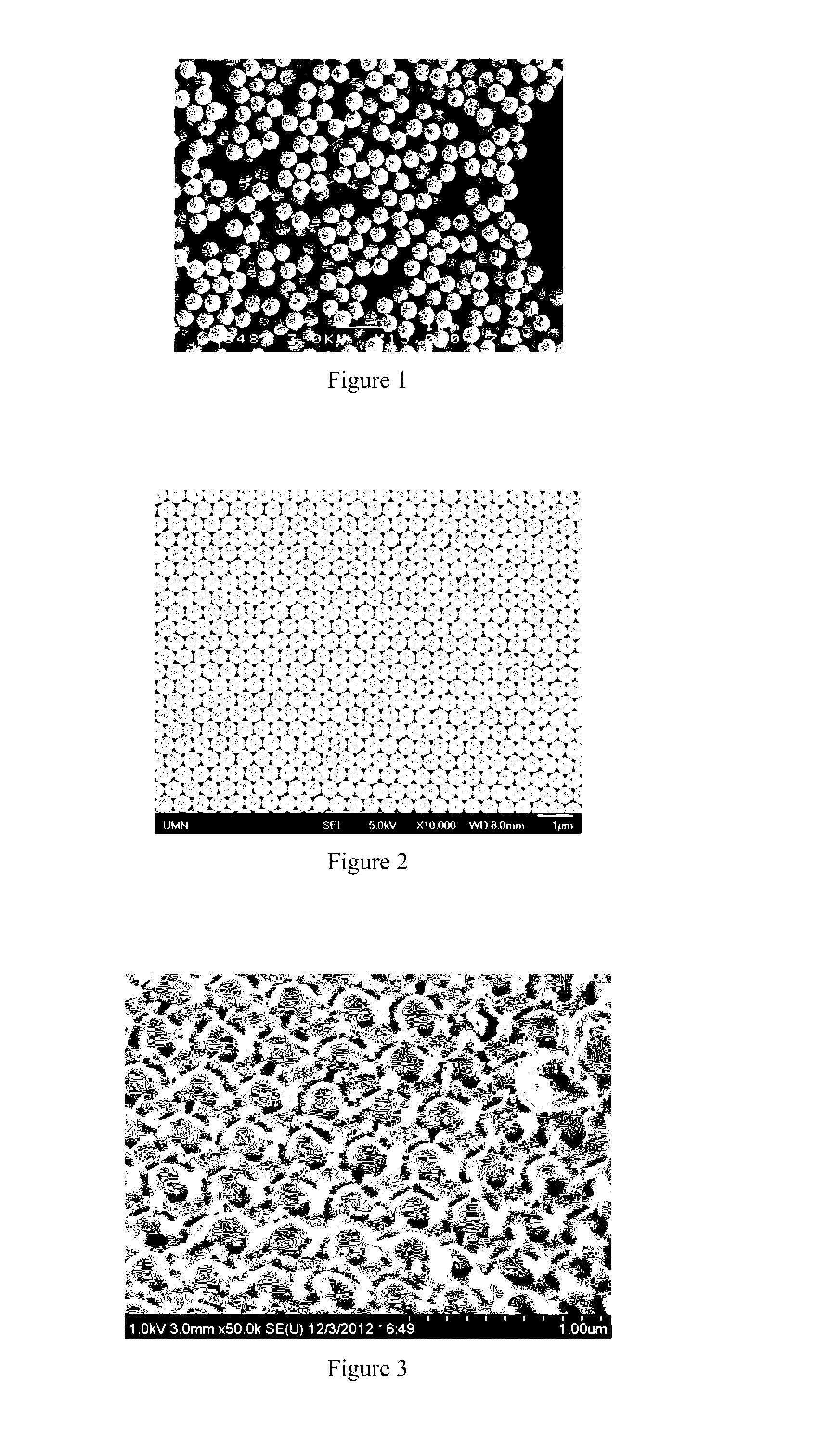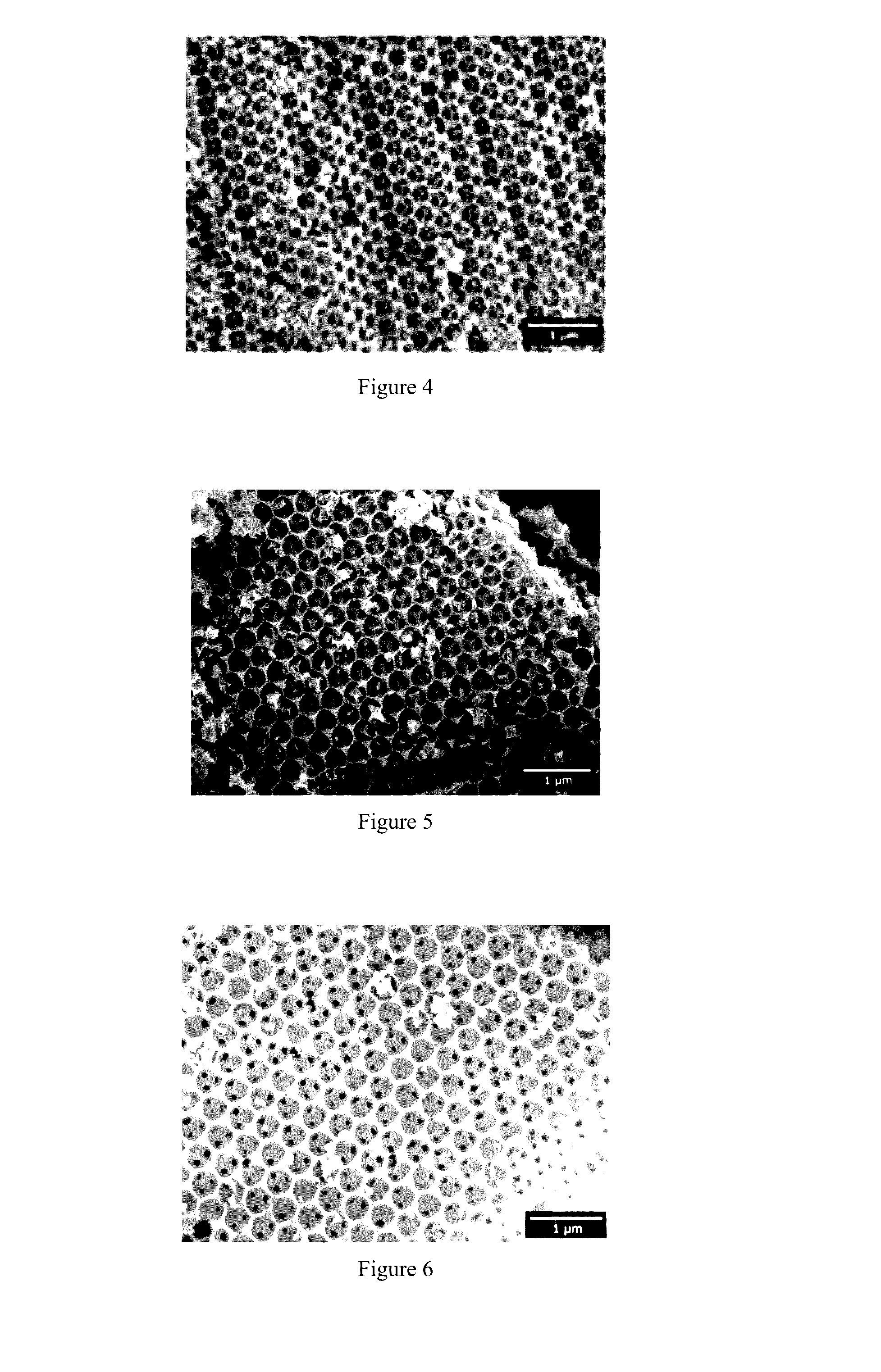Novel ordered macroporous materials
- Summary
- Abstract
- Description
- Claims
- Application Information
AI Technical Summary
Benefits of technology
Problems solved by technology
Method used
Image
Examples
example 1
Blue Ordered Macroporous Particles (Particles P1)
[0246]1.1. Preparation of the PMMA Spheres
[0247]In a 3 L jacketed reactor vessel equipped with a stirrer anchor type, 285 g of methyl methacrylate are loaded, and then 1.7 L of water. The stirring is started under a nitrogen stream in the reaction medium. The temperature of the jacket is raised to 90° C. When the reaction temperature reaches 78° C. and stabilizes, the catalyst (1.5 g) is quickly introduced into solution in water. The nitrogen flow is stopped and then after almost 6 hours at 90° C., the reaction mixture is cooled to room temperature. The suspension is then filtered through cotton and a suspension of 1.5 L containing 18% of a spherical PMMA is obtained.
[0248]PMMA Spheres Characterization by Laser Diffraction or Static Light Scattering (SLS) with Malvern Hydro 2000
[0249]10 g of PMMA suspension is diluted in 100 g of water and said solution is used for measuring the average diameter of the particles.
[0250]The measured ave...
example 2
Green Ordered Macroporous Inorganic Particles (Particles P2)
[0270]Preparing P2 particles takes place according to a protocol similar to that used for the preparation of the particles P1.
[0271]The size of the PMMA spheres is fixed at 410+ / −5 nm.
[0272]The diameter of the pores of the isolated P2 particles material is 336 nm+ / −5 nm.
[0273]The full volume fraction is calculated as 2.1% and the maximum reflection is obtained at a wavelength of λmax=554 nm by measuring diffuse reflectance.
[0274]The obtained particles have an average largest dimension of about 6 nm.
[0275]A SEB image allows verifying the ordered structure of the material, with pores perfectly aligned and allows verifying the required pore diameter distribution, i.e. a homogeneous pore diameter.
[0276]FIG. 5 represents said SEB image.
[0277]Measurements
[0278]The corresponding reflectance measurements were carried out on a detector diode spectrophotometer Hewlett Packard 8452A for illustrating the color intensity variation depen...
example 3
Red Ordered Macroporous Particles (Particles P3)
[0279]Preparing P3 particles takes place according to a protocol similar to that used for the preparation of the particles P1.
[0280]The size of the PMMA spheres is fixed at 480+ / −5 nm.
[0281]The diameter of the pores of the isolated P3 particles material is 360 nm+ / −5 nm.
[0282]The full volume fraction is calculated as 12.0% and the maximum reflection is obtained at a wavelength of λmax=626 nm by measuring diffuse reflectance.
[0283]The obtained particles have an average largest dimension of about 6 nm.
[0284]A SEM image allows verifying the ordered structure of the material, with pores perfectly aligned and allows verifying the required pore diameter distribution, i.e. a homogeneous pore diameter.
[0285]FIG. 6 represents said SEM image.
[0286]Measurements
[0287]The corresponding reflectance measurements were carried out on a detector diode spectrophotometer Hewlett Packard 8452A for illustrating the color intensity variation depending on the...
PUM
| Property | Measurement | Unit |
|---|---|---|
| Temperature | aaaaa | aaaaa |
| Length | aaaaa | aaaaa |
| Fraction | aaaaa | aaaaa |
Abstract
Description
Claims
Application Information
 Login to View More
Login to View More - R&D
- Intellectual Property
- Life Sciences
- Materials
- Tech Scout
- Unparalleled Data Quality
- Higher Quality Content
- 60% Fewer Hallucinations
Browse by: Latest US Patents, China's latest patents, Technical Efficacy Thesaurus, Application Domain, Technology Topic, Popular Technical Reports.
© 2025 PatSnap. All rights reserved.Legal|Privacy policy|Modern Slavery Act Transparency Statement|Sitemap|About US| Contact US: help@patsnap.com



